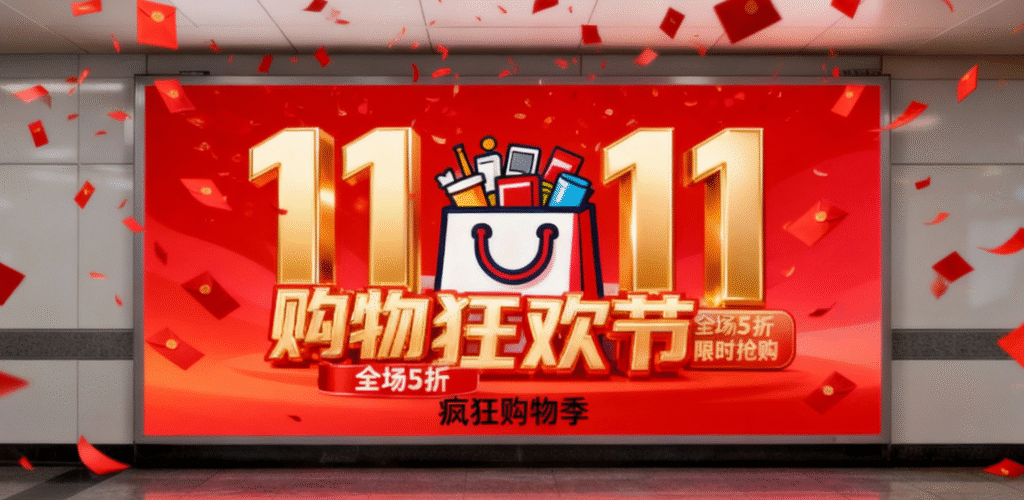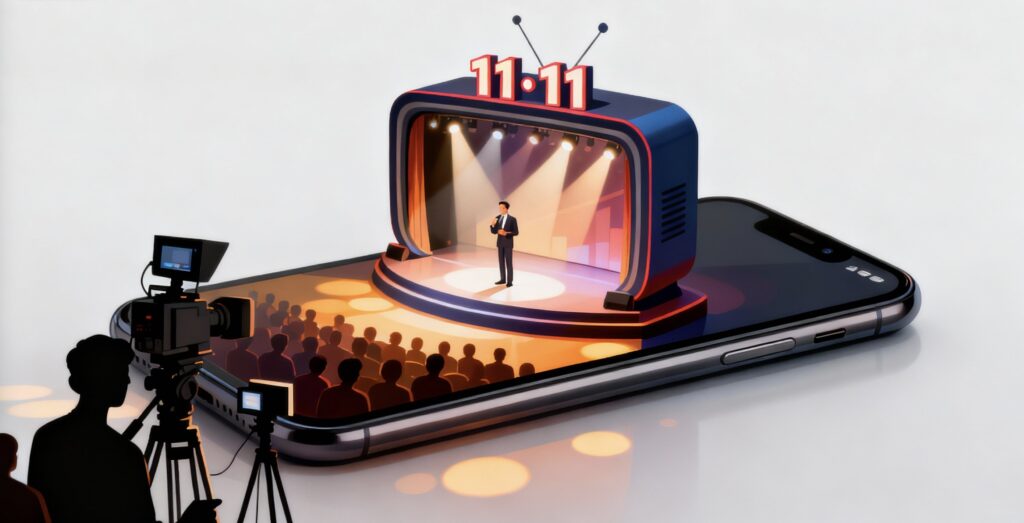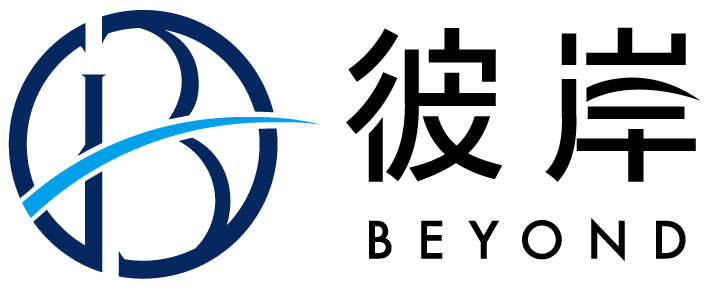China’s Biggest E-Commerce Festival Goes Back to Old Media

Table of Contents
Why a digital-native festival is borrowing TV-era humour to reconnect with retail-pro shoppers. This is not nostalgia. It is a strategy.
Double 11 was born in the browser.
Tabs, banners, flash sales, app only perks. For more than a decade, China’s biggest shopping festival has been the clearest expression of digital commerce at scale. If you wanted to understand platform power, you watched 11.11.
Seventeen years in, something unexpected is happening.
You open your phone and it feels strangely like television.
There are gala-style launch shows with celebrity hosts. Comedy sketches about prices that feel too high and quality that feels too low. Variety segments where KOLs argue with brand managers on stage to unlock one more bundle for the audience. Metro tunnels and outdoor boards start to look like classic brand campaigns again, with big slogans and simple promises.
The same platforms that taught China to swipe are suddenly speaking in the language of prime time.
This is not nostalgia. It is a strategy. A digital native festival is reaching for old media tools to solve a very modern problem: how to win back the trust and attention of consumers who now shop like professionals.
![]()



From tab takeover to variety show, in three quick moves
The journey here is simple.
Double 11 started as a one-day tab takeover, with a single promise of the lowest price of the year and a homepage drowned in banners. It then expanded into a long social season, with pre-sale, deposits, red envelopes, and mini games turning the festival into a week-long quest. Livestream commerce completed the shift, concentrating demand into a few super KOL rooms where split screens, countdowns, and complex coupon stacks made every purchase feel like a live performance.
For a while, each layer felt like an upgrade. Then the upgrades started to blur into noise.
By the seventeenth edition, the festival is no longer a surprise. Big purchases are planned around it. Every surface is loud, red banners and low price stickers melt into one. Most importantly, the audience has outgrown the script.
Chinese consumers now compare across platforms by default, track price movements before and after campaigns, share stacking tactics in WeChat groups and Xiaohongshu notes, and know which promises are real and which are cosmetic. They do not behave like rookies in a carnival. They behave like retail professionals managing their own portfolio.
In that world, one more hyperactive banner or intense livestream is not exciting. It is just more noise. So Double 11 reaches for something older and bigger than the feed: the emotional grammar of television.
Why old media is back in the frame
On the surface, it looks like a stylistic choice. More shows, more jokes, more long-form entertainment wrapped around the sale. Underneath, it is doing three jobs at once.
Rebuilding a shared moment
Early Double 11 felt like a shared countdown. Everyone knew when it started and when it ended. As the festival stretched into weeks of pre-sale and long tail, that sense of we are all here now faded.
Variety style launch nights, live galas, and heavily promoted specials pull focus back to a few big moments. They give platforms a central stage again, not just another slot in the scroll.
Owning the jokes before consumers do
Chinese shoppers have seen every play. Inflated original prices. Recycled lowest price claims. Bundles designed to confuse more than delight. So the campaigns lean into self-awareness.
They joke about products that are too expensive or not good enough. Hosts pretend to argue with stingy brand representatives on behalf of viewers. Skits show scammy sellers getting called out, then the platform stepping in as the hero.
It is theatre, but it is theatre built on real frustration. By laughing at the old tricks, platforms are trying to draw a line. That was then; this year, we are on your side.
Signalling a cleaner game without losing drama
Regulations around online promotions and misleading pricing have tightened. Public backlash against tone deaf comments and fake deals is faster and louder.
At the same time, the commercial pressure has not gone away. Platforms still want growth. Brands still need to make the quarter.
Old media formats offer a way to dramatise real value and real lowest price in a way that feels public and serious. Prices are revealed on stage in big type. KOLs assemble bundles live, with the maths visible before and after narratives are spelled out instead of being buried in fine print.
The message is simple. We know you are watching the details. We are willing to put them on a bigger stage.

The real protagonist: China’s retail pro shopper
Under all of this sits one hard truth.
Double 11 did not just create more buyers. It created better operators on the consumer side.
People have been training for this festival for more than a decade. They know how each platform plays to its strengths, when a claim feels wrong, and how price, quality, service, and cross-border options line up in their category.
That is the audience 11.11 year seventeen is speaking to. Not a naive mass, but a market of retail pros who expect offers they can summarise in one line, logic they can explain to a friend, and value that makes sense beyond the punchline.
Seen that way, the shift back to old media language is less about going backwards and more about changing the tone of the relationship. Less one-way hype, more we know you are not easy to impress, here is our case.
What global brands should take from 11.11 this year
For teams watching from Paris, London, or New York, the temptation is to fixate on formats: the gala, the sketch, the big show.
The more useful takeaway sits underneath.
Trust has quietly become the main creative brief. The jokes, the retro aesthetics, the staged fights for better prices all orbit one need, to make the price and the promise feel believable again.
Localisation now means respecting the audience’s intelligence. You are entering a space where consumers have a deeper, more granular understanding of discount logic and platform behaviour than most foreign headquarters. Your offers and storytelling have to assume that fluency.
Old media style combined with new media mechanics, needs a system behind it. Consistent pricing architecture, a clear value story, and a coherent creative language across TV style content, livestream rooms and short video are what separate a one off stunt from a brand that feels credible all year.
Seventeen years in, Double 11 is still a barometer for Chinese commerce. This year the signal is clear. Old media spectacle is being redeployed not to create hype, but to rebuild trust with a market of shoppers who already know the rules of the game.
For brands willing to meet those shoppers as peers, not targets, that is not a threat.
It is an opening.
